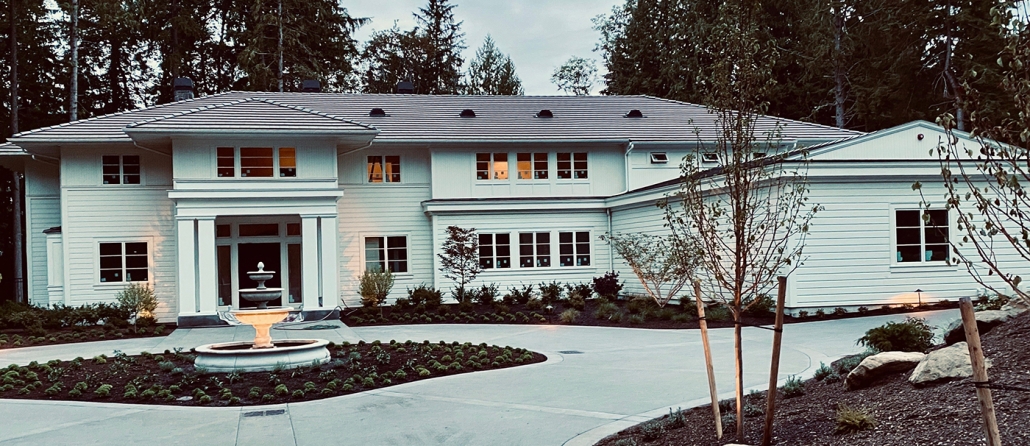The Grand Ridge Drive home is a modern mansion with eight-car garage, custom entry fountain, serene private garden, and state-of-the-art entertainment and security system.
Making changes that last generations
Communities just beyond the urban core provide major opportunities for growth.
In just the past year, the global pandemic has had a significant impact on most every facet of our personal and professional lives. And as much as we all want a “return to normal,” COVID-19 has instituted changes that are likely going to last for generations to come.
As leaders of full-service real estate company GIS Companies Group, we’ve given a great deal of thought to how COVID-19 will guide our firm’s future. Over the past few years, our team has built, developed, leased and sold several residential projects in and around the Seattle and Bellevue urban centers. While GIS will always look for new projects in the core, our team believes that the neighborhoods immediately surrounding the downtown core present significant new opportunities for growth — especially as buyers and renters seek to combine their work-life property needs in response to ongoing health and safety concerns.
The data supporting this urban-development trend is compelling. Historically low mortgage rates have made it easier for individuals and families to seek greater amounts of space to accommodate their occupational — and lifestyle-based requirements. What’s more, the National Association of Home Builders recently held a webinar titled, ”The Future of Urban and Suburban Housing in the Wake of COVID-19,” where panelists shared some interesting trends emerging in the housing industry — including much higher demand for housing in lower-density areas. At that same event, CoStar vice president for market analytics John Affleck stated that demand for multifamily units is increasing, too, particularly in markets just beyond the downtown core. Affleck added that trend actually started to take shape in advance of the global pandemic.
But capturing this market opportunity isn’t as simple as shifting your company’s focus from urban to outer-urban, or suburban, despite what some industry experts might say. Developing and building in communities just beyond the major employment centers takes a specialized approach. At GIS, we believe that creating, leasing and selling real estate in these specialized markets takes a sustained, long-term commitment, rather than a temporary shift in thinking in reaction to newly emerging demand.
As a result, we focus our efforts on a few fundamental offerings that have helped pave the way for a consistent deal flow in lower-density markets outside of both Seattle and Bellevue CBDs. This approach was instrumental in our ability to develop both Madison Plaza, a seven-story mixed-use project with 157 market-rate units in Kent, and Grand Ridge Drive villa, a 10,000-square-foot custom-built single-family home in the celebrated Issaquah Highlands neighborhood.
Relationships: There is an old saying that real estate is about location. We think it’s more about relationships. Moreover, success requires the ability to cultivate and maintain them successfully over time. Developing and building single- and multifamily projects in suburban neighborhoods — GIS is active in the South End and in various communities on Seattle’s Eastside — is more than bidding on land and creating a pro forma that meets your financial goals.
It’s about having strong relationships with independent landowners, local brokers, planners and other stakeholders who are the first to know about new-development opportunities. At GIS, relationship building is part of our DNA, a trait that will continue to serve us well in years to come as we look to build more projects out of the urban core.
Madison Plaza is a seven-story building with 157 market-rate units over a two-floor retail podium — and it’s just steps away from Kent Station.
Commitment: While GIS is focused on building trust in the community, we’re also committed to taking a long-term approach to development. When it comes to building outside the core, community stakeholders want to know that you are not there just for a single “turn-and-burn” project. It’s important to look at every development as the start of something special — the first of several homes or apartment buildings that will serve residents, retailers and employers in any given neighborhood.
Like any real estate company, GIS thrives on repeat business. But getting there requires patience, understanding and appreciation for what the neighborhood needs — rather than simply what can be built.
Entrepreneurialism: Creating projects in the core is a highly competitive process that requires keen market insights and astute business skills. Developing in the outer rings of downtown requires real estate savvy, too, especially when you’re venturing into less-validated communities that are just beginning to emerge.
To be successful, especially in uncertain times like today, requires every ounce of entrepreneurialism to make it work. Often, that means having a sixth sense about target demographics, future demand, and well-programmed amenities that serve residents’ needs but don’t duplicate existing nearby services. Making solid assumptions and taking safe risks on development comes with experience — and a flexible corporate structure that supports fast, local decision-making and sound real estate judgment.
Written by – Ryan Grams




